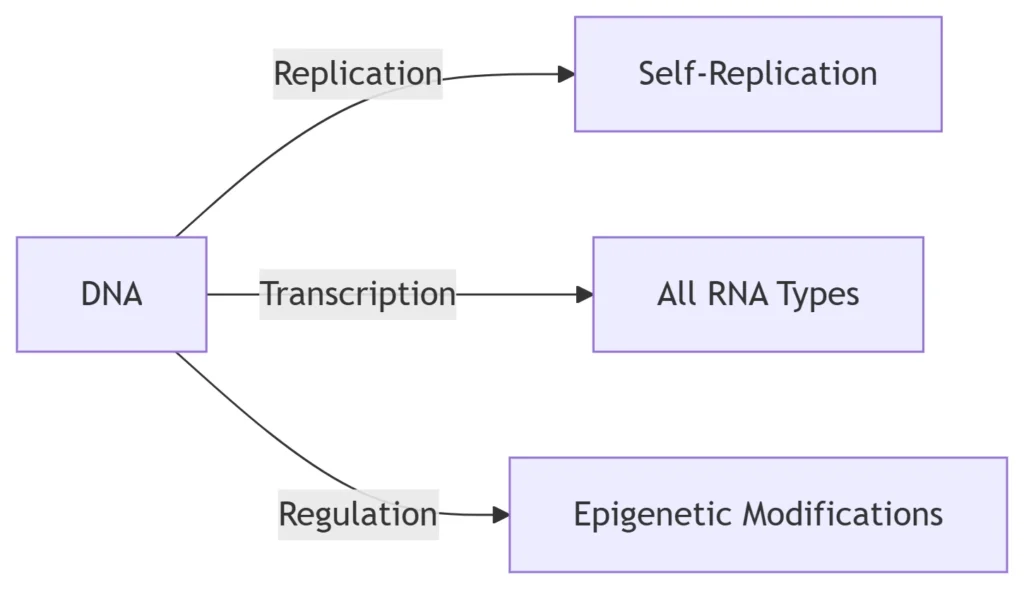DNA vs RNA: Key Similarities and Differences
An Integrated Analysis with Relationship Maps

I. Structural Comparison
| Feature | DNA | RNA |
|---|---|---|
| Sugar Backbone | Deoxyribose (lacks 2′-OH group) | Ribose (contains 2′-OH group) |
| Strand Topology | Double-stranded helix (B-form) | Single-stranded (forms stem-loops) |
| Nitrogen Bases | Adenine (A), Thymine (T), Cytosine (C), Guanine (G) | Adenine (A), Uracil (U), Cytosine (C), Guanine (G) |
| Helical Structure | Major and minor grooves | A-form helix (shorter, wider) |
| Stability | Highly stable (C-H bonds) | Labile (2′-OH group susceptible to hydrolysis) |
II. Functional Contrast
DNA Core Functions

-
Genetic Archive: Permanent storage of hereditary information
-
Autocatalysis: Self-replication via semi-conservative mechanism
-
Regulatory Hub: Contains promoters, enhancers, and silencers
RNA Functional Diversity

-
Information Transfer: mRNA carries codons for translation
-
Translation Machinery: rRNA (ribosomal), tRNA (adaptor molecules)
-
Gene Regulation: miRNA/siRNA (RNA interference), lncRNA (chromatin remodeling)
-
Catalytic Activity: Ribozymes perform enzymatic functions
III. Shared Characteristics
-
Chemical Foundation:
-
Both are polynucleotides with phosphodiester backbones
-
Utilize complementary base pairing (A-T/U, G-C)
-
Synthesized 5’→3′ direction
-
-
Genetic Roles:
-
Participate in central dogma of molecular biology
-
Contain non-coding functional sequences
-
Vulnerable to mutations affecting phenotype
-
-
Evolutionary Link:
-
Share common prebiotic origin
-
Mitochondria/chloroplasts contain both molecules
-
IV. Biological Significance of Differences
| Biological Process | DNA Involvement | RNA Involvement |
|---|---|---|
| Protein Synthesis | Indirect (template for RNA) | Direct (mRNA decoding at ribosomes) |
| Cellular Localization | Nucleus/mitochondria/plastids | Nucleus/cytoplasm/ribosomes |
| Evolutionary Role | Final genetic repository | Transitional molecule & remnant of RNA world |
| Biotech Applications | PCR, CRISPR, gene therapy | mRNA vaccines, RNAi therapeutics |
V. Relationship Synthesis Map

VI. Critical Implications
-
Disease Mechanisms:
-
DNA mutations (e.g., BRCA1): Heritable cancer risks
-
RNA errors (e.g., CAG repeats in Huntington’s): Toxic protein aggregation
-
-
Therapeutic Innovations:
-
DNA-targeting: CRISPR-Cas9 gene editing
-
RNA-targeting: mRNA vaccines (COVID-19), siRNA drugs (Patisiran)
-
-
Evolutionary Evidence:
-
RNA world hypothesis: Ribozymes in ribosomes support RNA’s primordial role
-
Viral strategies: Retroviruses (HIV) use reverse transcriptase to convert RNA→DNA
-
Conclusion
While DNA serves as life’s stable information repository, RNA functions as its versatile executor – translating genetic instructions, regulating expression, and even catalyzing reactions. Their structural differences (sugar chemistry, strand topology, base composition) enable complementary biological roles. Modern molecular biology exploits these distinctions: DNA manipulation enables permanent genetic changes, while RNA targeting allows transient therapeutic interventions. This synergy remains fundamental to all known life forms, from archaea to humans.
